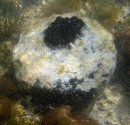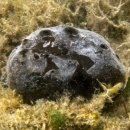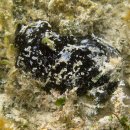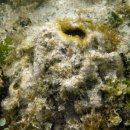| Common name(s): |
None |
| Growth Form: |
Irregular massive, globular or massive lobate to at least 30 cm across; usually with one to a few often depressed sieve plates on upper surface. |
| Surface: |
Smooth, non-porous but with several sieve areas bearing inhalant openings (ostia) 50-100 μm across each. Entire surface except exhalant oscule sieve plates usually covered with a combination of sediment, algae and encrusting sponges. |
| Color: |
Externally whitish in dark habitats (or under cover of encrusting sponges), dark brown where exposed to light. Interior cream-colored. |
| Consistency: |
Firm, slightly compressible. |
| Exudate: |
None. |
| Oscules: |
Small (0.3-1.2 mm across), clustered in well-defined circular to oval sieve plates on upper surfaces (1-8 cm across). |
| Skeletal Components (Spicules, Fibers): |
Several different spicule forms: 1) straight or slightly curved long (780-1900 x 20-40 μm) and short (125-250 x 2-4 (μm) rods with 2 gradually tapering pointed ends (oxea); 2) straight rods with 1 pointed end and 2-4 short diverging rays at the other end (orthotriaene, plagiotriaene) (420-900 x 15-22 μm); 3) spherical or oval with star-shaped holes (actually the tips of fused rays) (sterraster) (40-100 μm across); 4) small stars with short rays relative to the diameter of the center (spheraster) (4-10 μm across), and 5) small stars with roughened rays longer relative to the diameter of the center (10-30 μm across). No spongin fibers. |
| Skeletal Architecture: |
Long needle-like spicules oriented radially near the surface, with forked ends outward under a thick outer layer of sterrasters, with a thin outermost crust of small spherasters. Small stars also dispersed throughout interior. Interior arrangement of spicules confused. |
| Ecology: |
On shallow inshore hard bottoms often associated with seagrasses. Many specimens in the Florida Keys are encrusted with green Haliclona viridis or purple Haliclona sp. |
| Distribution: |
Bermuda, South Florida to Brazil; tropical west Africa, including São Tomé. |
| Notes: |
Agrees well with description in the literature. |
| References: |
Hooper & van Soest (2002). |
| Similar species: |

Spheciospongia vesparium |

Spongia obscura |

Spongia pertusa |

Aaptos pernucleata |
|

